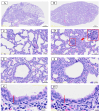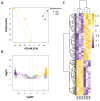Exploring Oxidative Stress and Metabolic Dysregulation in Lung Tissues of Offspring Rats Exposed to Prenatal Polystyrene Microplastics: Effects of Melatonin Treatment
- PMID: 39765788
- PMCID: PMC11672973
- DOI: 10.3390/antiox13121459
Exploring Oxidative Stress and Metabolic Dysregulation in Lung Tissues of Offspring Rats Exposed to Prenatal Polystyrene Microplastics: Effects of Melatonin Treatment
Abstract
Metabolomics research provides a clearer understanding of an organism's metabolic state and enables a more accurate representation of its functional performance. This study aimed to investigate changes in the metabolome of lung tissues resulting from prenatal exposure to polystyrene microplastics (PS-MPs) and to understand the underlying mechanisms of lung damage in rat offspring. We conducted metabolomic analyses of lung tissue from seven-day-old rat pups exposed to prenatal PS-MPs. Our findings revealed that prenatal exposure to PS-MPs led to significantly increased oxidative stress in lung tissues, characterized by notable imbalances in nucleic acid metabolism and altered profiles of specific amino acids. Furthermore, we evaluated the therapeutic effects of melatonin treatment on lung function in 120-day-old offspring and found that melatonin treatment significantly improved lung function and histologic change in the affected offspring. This study provides valuable biological insights into the mechanisms underlying lung damage caused by prenatal PS-MPs exposure. Future studies should focus on validating the results of animal experiments in humans, exploring additional therapeutic mechanisms of melatonin, and developing suitable protocols for clinical use.
Keywords: lung; melatonin; metabolome; microplastics; offspring; oxidative stress.
Conflict of interest statement
The authors declare no conflicts of interest. The funders had no role in the design of the study; in the collection, analyses, or interpretation of data; in the writing of the manuscript; or in the decision to publish the results.
Figures







Similar articles
-
The cardiovascular toxicity of polystyrene microplastics in rats: based on untargeted metabolomics analysis.Front Pharmacol. 2024 May 10;15:1336369. doi: 10.3389/fphar.2024.1336369. eCollection 2024. Front Pharmacol. 2024. PMID: 38799170 Free PMC article.
-
Metabolomics revealing the response of rice (Oryza sativa L.) exposed to polystyrene microplastics.Environ Pollut. 2020 Nov;266(Pt 1):115159. doi: 10.1016/j.envpol.2020.115159. Epub 2020 Jul 7. Environ Pollut. 2020. PMID: 32663678
-
Polystyrene microplastics exposition on human placental explants induces time-dependent cytotoxicity, oxidative stress and metabolic alterations.Front Endocrinol (Lausanne). 2024 Nov 20;15:1481014. doi: 10.3389/fendo.2024.1481014. eCollection 2024. Front Endocrinol (Lausanne). 2024. PMID: 39634179 Free PMC article.
-
Maternal exposure to polystyrene microplastics impairs social behavior in mouse offspring with a potential neurotoxicity.Neurotoxicology. 2023 Dec;99:206-216. doi: 10.1016/j.neuro.2023.10.013. Epub 2023 Nov 1. Neurotoxicology. 2023. PMID: 37918694
-
Adverse effects and potential mechanisms of polystyrene microplastics (PS-MPs) on the blood-testis barrier.Environ Geochem Health. 2024 Jun 7;46(7):238. doi: 10.1007/s10653-024-02033-z. Environ Geochem Health. 2024. PMID: 38849627 Review.
Cited by
-
Prenatal melatonin reprograms liver injury in male pups caused by maternal exposure to a high-fat diet and microplastics.Apoptosis. 2025 Jun;30(5-6):1502-1514. doi: 10.1007/s10495-025-02111-2. Epub 2025 Apr 11. Apoptosis. 2025. PMID: 40216644 Free PMC article.
-
Deciphering the Neurotoxic Burden of Micro- and Nanoplastics: From Multi-model Experimental Evidence to Therapeutic Innovation.Mol Neurobiol. 2025 Jul 4. doi: 10.1007/s12035-025-05174-z. Online ahead of print. Mol Neurobiol. 2025. PMID: 40615763 Review.
References
Grants and funding
LinkOut - more resources
Full Text Sources

